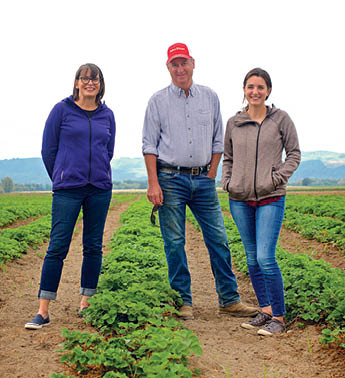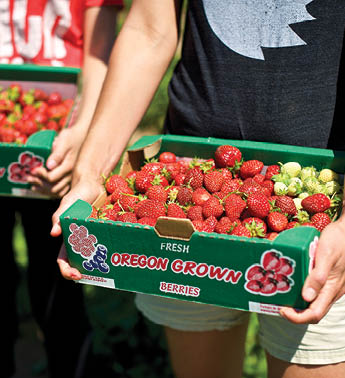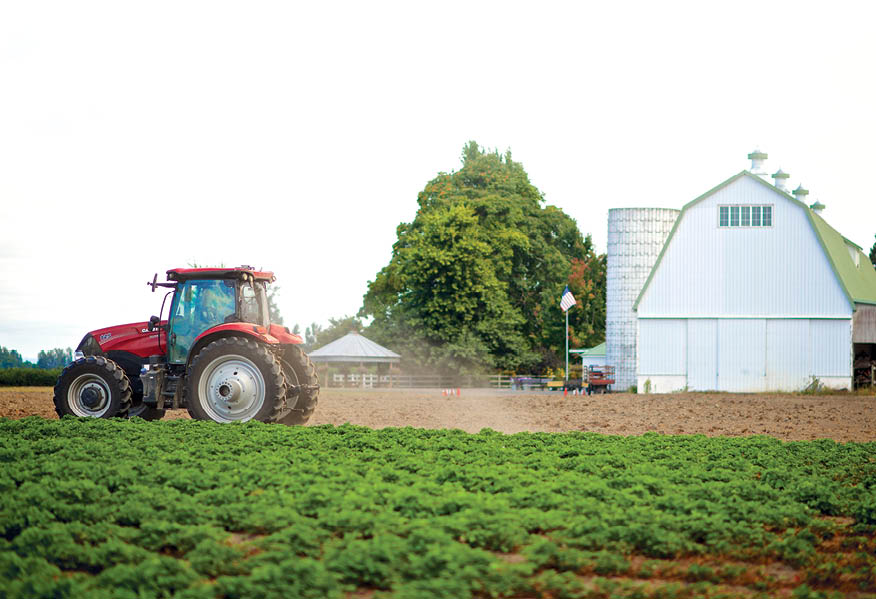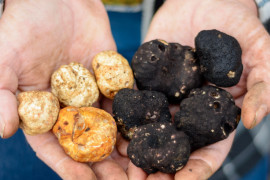
written by Sophia McDonald
photography by David L. Reamer
Come May, the rows of calf-high plants at Sauvie Island’s Columbia Farms have reached their full size and seem to stretch endlessly toward the horizon. Hidden beneath waterfalls of sawtooth-edged leaves are one of spring’s biggest treats—strawberries, some big, some small, all bright red and promising sublime sweetness.
Maybe it’s just that strawberries are the first fruit to come on the market after a long winter full of earthy storage crops and bitter greens. Maybe it’s that unparalleled flavor, coupled with their charming heart shape and striking color. There’s something special about this berry—especially for Oregonians, who live in one of the best berry-growing regions in the world and, as a result, have access to premium fruit during the short growing season.
So many people don’t know where their food comes from, and u-pick is a great way to bridge that gap.
Dave and Diane Kunkel, along with their daughter, Megan Hallstone, have been growing berries on Sauvie Island since the 1990s. Their 2,000-acre farm is home to a number of other crops, including wheat, grass seed and pumpkins. Dave Kunkel said, however, that berries are his favorite thing to grow. “They’re higher value and, quite frankly, it’s a lot more fun,” he said. “The people who get your product enjoy it and are thankful for it.” Fresh always wins over a package of frozen berries or a smear in the bottom of a stir-your-own yogurt cup.

To satisfy the varying needs of consumers, the Kunkels grow several types of strawberries. There’s nothing quite like the small, super-sweet Hood for fresh eating. Diane Kunkel prefers Puget Reliance for preserving. “When Megan and I do jam, we don’t use Hoods because when you add sugar to them, it’s almost like a cotton-candy flavor. Puget Reliance still has the strawberry flavor when you add the sugar to it.” From a grower’s perspective, Dave Kunkel prefers the Puget Reliance or newer Marys Peak because Hood plants only produce for one to two years.
The Kunkels pick some of their own berries to sell at Zupan’s Market in Portland and their farm stand. But many of their berry fields are set aside for u-pick. There are some distinct advantages to that. Hallstone welcomes the opportunity to educate people about how their food is produced. Columbia Farms engages in what it calls responsible farming rather than organic growing. Among
other things, it rotates its strawberry fields so fumigation isn’t necessary and monitors pests in the fields to only spray if needed.
“There’s a big misconception that organic means spray-free and that’s not the case,” Hallstone said. “So many people don’t know where their food comes from, and u-pick is a great way to bridge that gap.”
U-pick also helps them work around one of the biggest challenges for most farmers—labor. It’s hard to find people to pick berries, although they’ve found that teachers looking for summer employment are a pretty reliable source. And as Hallstone explained, it’s hard for farmers to keep up with the growing costs of employees. “With the majority of crops in farming, you don’t set your own price.” Instead, they’re set by international commodity markets, wholesalers or retailers. “So when minimum wage keeps going up, most businesses can just increase their prices to cover that, but in farming you can’t.” Selling direct-to-consumer allows the Kunkels more flexibility to charge the prices necessary to cover costs.
Having customers on a working farm presents some challenges, of course. There are always safety considerations when there’s large equipment around. A sticking point with many people is that they can’t bring their dogs into the u-pick fields—something that’s banned because of food safety regulations.
But the yearly ritual of inviting people to become part of their farm, even if it’s just for an hour or two, is something the family has no plans to give up. If nothing else, they all look forward to seeing the people they describe as the best customers a business could ask for. “You can count on one hand in our twenty-some years the times that we felt like somebody stole from us,” Dave Kunkel said. “To this day, somebody will show up and they’ve forgotten their money, and we give them a receipt and say, ‘Send us a check.’ And it always comes.”
California and Florida are the top strawberry-producing states in the country, but Oregon regularly falls within the top five. According to Matt Unger, co-founder at Unger Farms Inc. and chairman of the Oregon Strawberry Commission, the volume of strawberries produced in the Willamette Valley has been declining since the 1980s. “Strawberries don’t have a real big fresh market compared to blueberries,” he said. “Oregon strawberries are more delicate, so they don’t have the longest shelf life.” They also face stiff price competition from California and Mexico. But while berries from these southern neighbors may be cheaper, Oregon has a real advantage when it comes to quality.
Strawberry shortcake is one of the most common uses for super-sweet summer berries. For Mother’s Day or any other occasion, try the recipe from Lisa Schroeder, owner of Portland’s famed Mother’s Bistro and Bar.
An alternative to the traditional shortcake is strawberry cassata from chef Ken Boyle at Salishan Resort in Gleneden Beach. Sweetened ricotta cheese and strawberry syrup are sandwiched between layers of almond-flavored cake.
Strawberries make great jam, but another way to preserve them is by making a shrub, in which berries are packed in sugar and vinegar. The liquid is delicious in cocktails like this Strawberry Pimm’s Cup, developed by Eddie Riddell, bar manager at Portland’s Trifecta.









